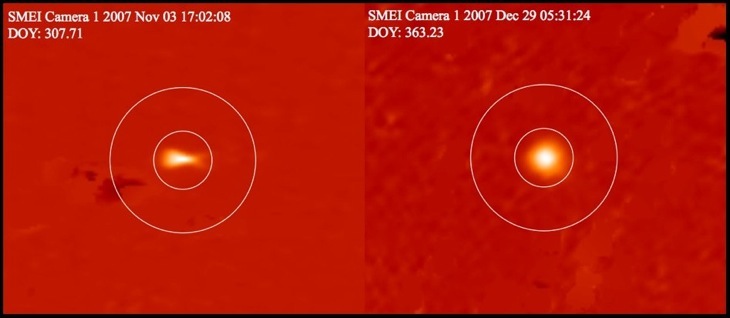
Outburst of Comet 17P/Holmes Observed With the Solar Mass Ejection Imager (SMEI)
Jing Li , David Jewitt (UCLA) and John Clover and Bernard Jackson (UCSD)
Astrophysical Journal, in press (Dec 06 2010)
Abstract
We present time-resolved photometric observations of Jupiter family comet 17P/Holmes during its dramatic outburst of 2007. The observations, from the orbiting Solar Mass Ejection Imager (SMEI), provide the most complete measure of the whole-coma brightness, free from the effects of instrumental saturation and with a time-resolution well-matched to the rapid brightening of the comet. The lightcurve is divided into two distinct parts. A rapid rise between the first SMEI observation on UT 2007 October 24 06h 37m (mid-integration time) and UT 2007 October 25, is followed by a slow decline until the last SMEI observation on UT 2008 April 6 22h 17m (mid-time). We find that the rate of change of the brightness is reasonably well-described by a Gaussian function having a central time of UT 2007 October 24.54+/-0.01 and a full-width-at-half-maximum 0.44+/-0.02 days. The maximum rate of brightening occurs some 1.2 days after the onset of activity. At the peak the scattering cross-section grows at 1070+/-40 km^2/s while the (model-dependent) mass loss rates inferred from the lightcurve reach a maximum at 3x10^5 kg/s. The integrated mass in the coma lies in the range (2 to 90)x10^10 kg, corresponding to 0.2% to 10% of the nucleus mass, while the kinetic energy of the ejecta is (0.6 to 30) MTonnes TNT. The particulate coma mass could be contained within a shell on the nucleus of thickness 1.5 to 60 m. This is comparable to the distance travelled by conducted heat in the century since the previous outburst of 17P/Holmes. This coincidence is consistent with, but does not prove, the idea that the outburst was triggered by the action of conducted heat, possibly through the crystallization of buried amorphous ice.
Caption: Sample images of 17P/Holmes from SMEI Camera 1 taken 2007 November 3 (top) and December 29 (bottom). The region shown in each panel is 14.9 deg x 12.9 deg (149 x 129 pixels) across with North to the top and East to the left. Background stars brighter than 6th magnitude have been removed. The circles around comet 17P/Holmes have radii 1.2 deg, and 3.0 deg, respectively. On November 3, Holmes was unresolved, showing the intrinsic, fish-like SMEI image shape (left). By the end of December 2007, 17P/Holmes was partially resolved by SMEI so that the image appears more as a fuzzy ball (right).
Click on the Figure to see a movie of Comet Holmes as seen by SMEI.
Contact
Jing Li [jingucla@gmail.com], David Jewitt [jewitt@ucla.edu

